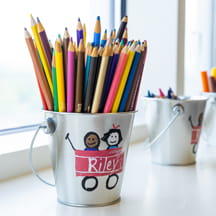They are items that can be found in any classroom across the country — colorful curtains with images of pencils or a bottle of cleaning solution, ready for inevitable spills. But these simple, everyday items could pose environmental hazards to students and affect their long-term health. Children's Mercy Kansas City helps schools identify and remedy these potential risks through its Healthy Schools and Childcare Program.
The Children’s Mercy initiative began as an offshoot of the hospital’s home-based program, conducting investigations for schools based on immediate health needs only. About 15 years ago, Children’s Mercy’s environmental health team collaborated with a local school district to develop a pilot program to address potential environmental concerns before they become health hazards.
Over the years, the program has evolved to address three primary areas: room environments, education and training, and policy and planning.
Room environments
The Healthy Schools and Childcare team assesses the environmental, safety, and security aspects of every space in the school buildings they audit. Those audits come about in a variety of ways. In some cases, a concerned parent contacts Children’s Mercy, sparking a conversation with the school. Sometimes, school officials initiate the audit process due to specific environmental concerns. In many cases, the audits are regularly scheduled assessments within school districts that have long-standing relationships with the Healthy Schools and Childcare Program.
“One district has 50 buildings, so we're doing 10 audits every year. Each building is assessed once every five years, and the good thing about that is it gives them some baseline data,” says Luke Gard, CIEC, program manager of the program. “That’s a good example of a school district that over time has realized the value of our service.”
For audits, the team visually inspects every room and space in the school building across seven domains:
- HVAC and ventilation. Evaluates the condition of windows and vent systems and the presence of portable fans and heaters.
- Cleanliness and allergens. Measures the presence of dust, plants, pests, and unsanitary conditions.
- Moisture control. Assesses for signs of moisture stains or musty odors.
- Room contents. Includes the presence of any potential sources of fragrances or odors and flaking paint.
- Safety and security. Checks electrical and fire hazards and the presence of emergency notifications and preparedness, among other things.
- Learning environment. Assesses whether lighting and noise levels are conducive to a healthy learning space.
Education and training
Children’s Mercy includes a series of training and education sessions with its school building audits, each tailored to key constituencies:
- Teachers. A one-hour presentation delivered during a school’s professional development day. This session reviews items to avoid bringing to classrooms and provides education on the health implications of their surroundings.
- Custodial staff. A full-day seminar on the care and management of the buildings and how it affects the health of everyone inside. Topics include pest control, mold prevention, safety, and security.
- Nurses. A session focusing on the relationship between environmental factors and illness and how to identify environmentally driven health trends among students. It includes an hour-long module on asthma management that counts toward continuing education credits.
- Administrators. A high-level overview designed to cultivate potential internal “champions” for the program. “Whether it's the superintendent, nursing coordinator, or director of facilities, you need somebody high up within the organization who sees the value in doing this and can create a culture that becomes self-sustaining,” Gard says.
Policy and planning
The Healthy Schools and Childcare team works closely with statewide associations, including those representing the state’s school boards, school nurses, and school facility directors, to influence broad policy and procedural changes.
“The last several years we've worked more from a community perspective to support these organizations with short-term and long-term recommendations,” Gard says. “We want to provide them with evidence-based guidance so they can do their best with what they have to manage their buildings.”
At the school district level, the audits help inform policy decisions. Findings from individual school assessments can uncover patterns repeating at other schools across the area. Recommendations for one school often lead to pre-emptive process changes for all schools in a district, according to Gard.
Just do it
In addition to ad hoc investigative projects, Children’s Mercy has ongoing arrangements with three area school districts, encompassing nearly 100 buildings and more than 50,000 students. Gard says a commitment of that scope may seem overwhelming, but the key is to not be afraid of starting small.
“It can be daunting to think about trying to incorporate these changes into your systems, your philosophy, and your culture, but you just have to take that first step,” Gard says.



